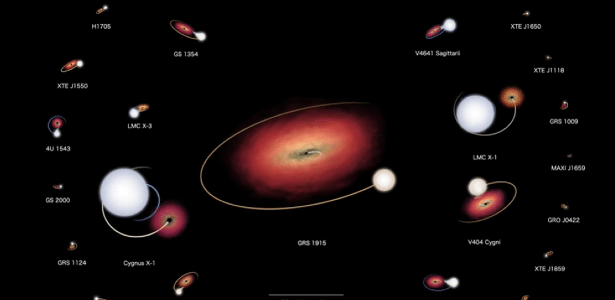A new video released by NASA shows what the dynamics between Earth’s closest black holes and their companion stars look like. The animation features 22 binary systems located in the Milky Way and our neighboring galaxy, the Large Magellanic Cloud, which host black holes of confirmed stellar mass.
In the images you can see in each pair that the binary systems consist of a star orbiting a black hole. In each part of the animation, the black hole is represented by a black dot located in the center of the accretion disk.
The colors of the stars in the video range from bluish white to red, indicating temperatures five times higher or 45% cooler than the Sun, respectively.
According to the space agency, the star appears as a bluish-white or yellow ball of proportional size.
Another detail is that the systems appear on the same physical scale, which indicates diversity. Orbital motion is accelerated 22,000 times and the viewing angles are the same as we see from Earth. Black holes appear on a scale that reflects their respective masses, appearing to be larger than they actually are.
When the material is heated on the disk as it falls in Black holeit glows in visible and ultraviolet light, and X-rays can take pictures – due to darkness, black holes cannot be seen through a telescope.
According to NASA, astronomers have yet to come to a consensus on how the system in the center of the video, GRS 1915, operates at a distance greater than that between Mercury and the Sun, for example.
What is a black hole
A black hole is a region in space where the gravitational force is so strong that not even light can escape from inside it. Once a black hole is formed, the gravity in the black hole region is so strong that All materials you are attracted to are compressed until they are destroyed.
Each star with a mass 20 times the mass of the Sun will turn into a black hole when it “dies”.
Despite what the name says, black holes shine – not on their own, but by interacting with a companion star to detect them. Therefore, astronomers note the relationship between these celestial bodies. And the best way to do this is to look at an X-ray.
A binary black hole can collect energy (feed) on its star in two ways. The first is that a stream of gas can flow directly from the host galaxy’s star into the black hole, spinning “like water in a drain.”
The second is when the star’s solar wind pushes material into the black hole. When a substance is “used up”, a huge amount of energy is released, in the form of x-rays.
Cygnus X-1, first thing
The first black hole known to researchers is Cygnus X-1, and it weighs 21 times the mass of the Sun.
Its surface, called the “event horizon”, is about 124 kilometers long – which is considered very small for a black hole. However, the visualization shows that Cygnus X-1 is much larger, more in line with the black hole’s mass than its size.
The larger spheres also mask the visible distortions caused by the gravitational effects of black holes.

“Incurable thinker. Food aficionado. Subtly charming alcohol scholar. Pop culture advocate.”






More Stories
NASA Releases Selfie of Perseverance Rover Working on Mars
NVIDIA driver includes hidden Final Fantasy XVI profile
PlayStation Plus Extra and Premium saw a significant drop in players in July